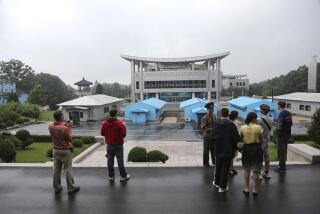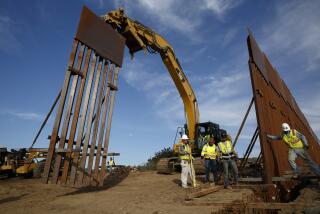DMZ, Korea Buffer an Ideal Wildlife Refuge : Ecology: Time heals scars of warfare, but either renewed fighting or peaceful reunification could prove disastrous to feathered inhabitants.
- Share via
CH'ORWON, South Korea — A sniper’s bullet nearly took off his head the first time Curtis Halvorson was in the Ch’orwon Valley.
Now, when the 64-year-old former infantryman roams through places like Pork Chop Hill and Old Baldy, where many of his fellow soldiers died four decades ago, the only things whistling through the air have wings.
“Hills that had been pounded into bare rubble by artillery have all grown back,” said Halvorson, a retired wildlife biologist from Ft. Collins, Colo. He manned a machine gun during the three-year Korean War, which ended in 1953. Now he returns to count birds.
Today, rare cranes, egrets and golden eagles are among the creatures that swoop and whirl over former killing fields along the demilitarized zone separating North and South Korea.
The DMZ, lined on either side with enough weapons to kill every person on this divided peninsula, has become an unintended wilderness refuge, teeming with furred and feathered creatures.
But the fate of the zone’s abundant wildlife, which includes white storks, bears, deer, pheasants, ducks, wildcats and possibly even tigers, hangs precariously on the continuing debate over North Korea’s reported nuclear weapons program.
A renewal of fighting would wipe out this ironic island of life in a potential sea of death. But the opposite extreme--peaceful reunification of the North and South--could prove almost equally disastrous.
“Because the Ch’orwon basin is one of the few relatively flat areas along the DMZ, people are already talking about developing it as a sort of a model reunification city as soon as the North and South start getting along better,” said another bird counter and wildlife biologist, Fran Kaliher of Two Harbors, Minn. “But at the moment, at least, it’s just this little paradise for wildlife.”
Halvorson and Kaliher are among a small group of Americans who not only hope this natural paradise won’t be lost, but who see it as a possible model for preserving similar Cold War borders throughout Europe and Asia as wilderness corridors.
“The whole former Soviet Union and China are ringed with borders that in many cases have held back development and are de facto wildlife refuges,” said David Thompson of the International Crane Foundation in Baraboo, Wis. “It may sound a little bit like a crazy idea now, but 50 years from now it might be seen as having been visionary.”
The zone was created in July, 1953, as part of the agreement that ended fighting between North Korea and the U.S.-led United Nations forces.
The DMZ is a perfect bedroom for animals: It has no human residents except for a few around Panmunjom, site of truce talks, and heavily armed soldiers in scattered guard posts.
Food for the wildlife is readily available within both the DMZ and the civilian control zone, the strip where South Korean authorities allow rice farming along the DMZ’s southern border.
This arrangement is especially good for wintering cranes. By day they feast on leftover grain. At night they retire into the sanctuary of the DMZ and its rich network of streams and rivers.
For now, the two most notable animals known to be in the area are red-crowned cranes and white-naped cranes, both endangered species.
A 963-square-mile area in the Ch’orwon Valley serves as the winter home for almost 300 red-crowneds and 350 white-napeds. An additional 2,000 white-napeds stop over for several weeks each year during their spring migration from Japan to Russia and northeastern China.
“If the DMZ were wiped out this year by war, the cranes would eventually find their way to China,” said Kaliher. “But none of the situations in China are as good as this one at the moment--an area that is totally off-bounds to civilians.”
More to Read
Sign up for Essential California
The most important California stories and recommendations in your inbox every morning.
You may occasionally receive promotional content from the Los Angeles Times.













